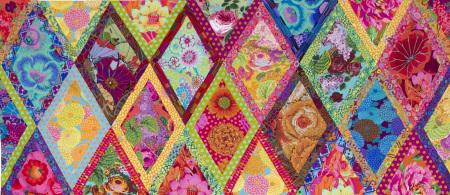This post has become an annual tradition! In ten years of writing this interfaith blog, I have posted multiple essays on many of the spring Jewish and Christian holidays: Purim, St Patrick's Day, Passover, Easter. But the complex, interlocking quilt squares of #GenInterfaith now go far beyond Judaism and Christianity.
My new book The Interfaith Family Journal, is designed for all interfaith families, of any or all religions, or none. And while we make many different choices about what to believe, how to practice, and where to affiliate (or not), all of us in extended interfaith families (and increasingly, that is most of us) benefit from multi-sensory interfaith experiences with extended family, neighbors, and co-workers.
Just in the coming weeks, we have a dense schedule of holidays (for a more complete list go here). Note the ancient connections many of these holidays have to the spring equinox, and often, to each other. Religions and cultures are not static, but change in response to neighboring religions and cultures, just as we do as individual members of interfaith families.
Feb 21, Mahashivaratri, the Hindu festival honoring Lord Shiva, includes staying up all night to meditate, chant, and dance, in the darkest season. Check out the twitter hashtag #DontYawnTillDawn.
Feb 25, Shrove Tuesday (Mardi Gras). For Roman Catholics and some Protestants, this day marks the end of feasting before the beginning of fasting for Lent. Shrove Tuesday is the finale of Carnival (Shrovetide), with notable multi-day celebrations in Brazil, Trinidad and Tobago, New Orleans, Venice, and some Protestant regions. Carnival may have many historical ties to the pre-Christian celebrations of the return of the sun.
Feb 26, Ash Wednesday marks the start of Lent, the period of fasting before Easter, for Roman Catholics and some Protestants.
March 9, Magha Puja Day. Buddhist commemoration of Buddha delivering the principles of Buddhism, on the full moon. Celebrated in Southeast Asia with temple visits, processions, and good works.
March 10, Holi. Hindu commemoration of the arrival of spring and love, celebrated with bonfires, throwing powdered color pigments and water on each other, music, feasting, forgiving debts, repairing relationships, and visiting. Popular even with non-Hindus in South Asia, and increasingly (and not without controversy over appropriation) throughout the world.
March 10, Purim. Jewish commemoration of the Biblical story of Esther in ancient Persia, celebrated with costumed reenactments, three-cornered pastry (hamantaschen), drinking, and charity. There may be a historical connection between Norooz and Purim.
March 10, Hola Mohalla. Sikh celebration including processions, mock battles, poetry reading, music. There is a historical connection between Hinduism's Holi and Hola Mohalla.
March 17, St Patrick's Day. Catholic commemoration of the Feast Day of St Patrick, primarily celebrated by Irish-Americans with parades, drinking, and the wearing of the green, as a way to connect with Irish culture. Now celebrated in America by people of many religions. Possible historical connection to Ostara.
March 20. Spring Equinox. Ostara, ModernPagan/Wiccan commemoration of the spring equinox and Eostre, the Saxon lunar goddess of fertility. Celebrated with planting of seeds and nature walks. Possible historical connections between Eostre, Easter, Passover, and Norooz.
March 21, Norooz (Naw-Ruz). Zoroastrian/Bahai/Persian celebration of the New Year on the spring equinox. With roots in ancient Iran, it is celebrated by many people of all religions together, throughout the Balkans, Caucasus, Central and South Asia, and the Middle East with spring cleaning, flowers, picnics, feasting, and family visits. Possible historical connection between Norooz and Purim.
April 9, Maundy Thursday. Protestant and Roman Catholic commemoration of The Last Supper. There may ( or may not) be a historical connection between The Last Supper and the Passover seder.
April 10, Good Friday. Protestant and Roman Catholic commemoration of the Crucifixion of Jesus, with church services and fasting.
April 12, Easter. Protestant and Roman Catholic commemoration of the Resurrection of Jesus, celebrated with church services, family dinners, and baskets of candy for children. Fertility imagery including bunnies and eggs may, or may not, have a historical connection to pre-Christian rituals and the spring equinox.
Sundown on April 8 to April 15, Passover (Pesach), Jewish commemoration of the flight from Egypt described in the book of Exodus. Primarily a home-based celebration with one or more festive Seder meals of ritual foods, songs, and prayer. As with Easter, Passover incorporates (presumably pre-Judaic pagan) spring equinox fertility symbolism (eggs, spring greens).
April 19, Orthodox Easter (or Pascha) in many of the Orthodox Christian traditions using the Julian rather than Gregorian calendar, including Bulgaria, Cyprus, Ethiopia, Greece, Lebanon, Macedonia, Romania, Russia, and Ukraine, as well as millions of people in North America. Many of these cultures include a feast of lamb (connected historically to Passover) and hard-boiled eggs (connected to more ancient fertility traditions).
April 24, start of the month-long daytime fast for Ramadan in Islam, commemorating the revelation of the Qu'ran. Muslim holidays are on a lunar calendar, so move through the seasons over time.

Journalist Susan Katz Miller is an interfaith families speaker, consultant, and coach, and author of Being Both: Embracing Two Religions in One Interfaith Family (2015), and The Interfaith Family Journal (2019). Follow her on twitter @susankatzmiller.

